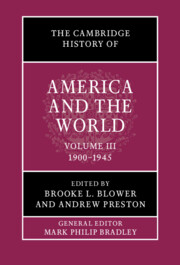Book contents
- The Cambridge History of America and the World
- The Cambridge History of America and the World
- The Cambridge History of America and the World
- Copyright page
- Contents
- Figures
- Maps
- Contributors to Volume III
- General Introduction: What is America and the World?
- Introduction to Volume III
- Part I American Power in the Modern Era
- 1 The Sinews of Globalization
- 2 The Territorial Empire
- 3 Waging World War I
- 4 Technological Transformations
- 5 Law and American Power
- 6 Latin America and US Global Governance
- 7 Transatlantic Relations
- 8 The Open Door, Tsarist Russia, and the Soviet Union
- 9 The Rise of the Modern Middle East
- 10 Competing Empires in Asia
- 11 Making a Modern Military
- Part II Competing Perspectives
- Part III The Perils of Interdependence
- Index
4 - Technological Transformations
from Part I - American Power in the Modern Era
Published online by Cambridge University Press: 12 November 2021
- The Cambridge History of America and the World
- The Cambridge History of America and the World
- The Cambridge History of America and the World
- Copyright page
- Contents
- Figures
- Maps
- Contributors to Volume III
- General Introduction: What is America and the World?
- Introduction to Volume III
- Part I American Power in the Modern Era
- 1 The Sinews of Globalization
- 2 The Territorial Empire
- 3 Waging World War I
- 4 Technological Transformations
- 5 Law and American Power
- 6 Latin America and US Global Governance
- 7 Transatlantic Relations
- 8 The Open Door, Tsarist Russia, and the Soviet Union
- 9 The Rise of the Modern Middle East
- 10 Competing Empires in Asia
- 11 Making a Modern Military
- Part II Competing Perspectives
- Part III The Perils of Interdependence
- Index
Summary
On February 9, 1904, President Theodore Roosevelt appointed a special Commission to oversee what would soon become the most prodigious engineering project undertaken to that time in human history. Having conspired to stage a near-bloodless coup with the support of local notables that compelled Columbia to cede its sovereignty over the Isthmus of Panama, the president cleared the way for the United States to construct a sea route between the Atlantic and Pacific Oceans across the narrow waist that joined the two continents of the Western Hemisphere. The region’s dense rainforests and mountainous terrain contributed to the audacity of the enterprise that prompted many contemporary observers to predict that it would likely prove an extravagant failure. That expectation also appeared to be substantiated by the experience of the prestigious corps of French engineers, who under the direction of Ferdinand de Lesseps had built a canal across the Suez desert in the 1860s, but failed dismally in their attempt (also directed by Lesseps) to carve out a similar waterway across Panama between 1881 and 1889. But the pessimists failed to consider the remarkable advances in technology, the education and organization of engineers, and applied science – especially medicine – that had been made in the United States in the second half of the nineteenth century. These breakthroughs were essential for impressive increases in scale, organization, and productivity across the main sectors of the transcontinental economy that occurred in the first decades of the twentieth century, and the consequent improvement in living standards for ever-greater numbers of Americans. The technological and scientific advances that made for the success of the Panama Canal project provided the basis for further major innovations in the half century that followed. These undergirded the emergence of the United States as an engine of global material increase and a dominant military and political power.
- Type
- Chapter
- Information
- The Cambridge History of America and the World , pp. 108 - 129Publisher: Cambridge University PressPrint publication year: 2022

